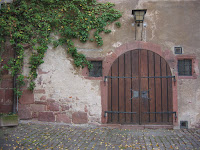Keith Martel and Brian Jensen "are weary of books that turn leadership into a technique or a program." They "recognize that leadership is not a form of coercion or a mode of control; rather it is a relationship. It is a pattern of social life and that pattern emerges in a narrative context." To that end, they wrote Storied Leadership. All quotes presented here are from this book.
Storied Leadership starts at the foundation. The authors "contend that the assumptions held about reality are the ultimate foundation of one's perspective on leadership." Thus, "every leadership model and all acts of leading are manifestations of the stories that we believe." Stories? What are they talking about? To provide more detail:
All narratives are embedded with certain assumptions about the limits and possibilities of humans, the problems of the world and what creates them, and possible solutions to these problems. People always lead and influence others- for good and for ill- out of the stories that have captured their hearts and shaped their commitments.The authors are Christians; accordingly, the story that has captured their hearts is the Gospel, as presented in the Bible. Storied Leadership summarizes the Gospel story, and then discusses leadership principles and practices that arise out of it (or because of it).
The (extremely condensed) Gospel is as follows:
God created the world. He made man and woman, in His image, to share in this created order- to enjoy, shape, and care for the Earth. To create culture and be stewards. All was perfect.
Humans went outside the limits given to them; they disobeyed, fell from perfection, and in so doing, irrevocably damaged the relationship with our Holy God. Because of their sin, humanity (and even all of creation) was forever distorted.
Humans could do nothing to fix the rift they had created, but God could. Because He is holy, He could not overlook the sin . . . so He paid the price for it Himself, in the form of Jesus (God in flesh) dying on the cross as payment for man's fall. Because of His sacrifice, we have been reconciled with the Lord, and now live in a time of restoration. The world and humanity are not perfect- we still have the distortion, the mark of the fall. But we have been redeemed, and thus "we are in a world of gravity and grace- distortion and renewal."
The Gospel can be summarized as Creation, Fall, Redemption. In a nutshell, "perfection distorted and restored." It is the basic story of Christianity, and fundamental to the Christian's worldview. Storied Leadership uses this story as the foundation from which leadership happens. Specifically, from the Creation mandate, leaders are to be loving lords.
The loving lord is the one who protects the limits and draws out the possibilities. She is able to consider the potential of her subject and nurture it toward maturity. The loving lord leads the created order into the way it is meant to be . . . loving lordship seeks to bring out the fullness of something for the common good and for the benefit of the thing itself.Said another way, "We are called to lead the nascent creation from potentiality into actuality." To
"Guard and till. Preserve and cultivate." But it's not just about this.
Because of the Fall, "All has been distorted." Thus, "Our role as image bearers is also the work of reconciliation." That can mean we're called to fix in addition to creating. So, we are called to be "cultivators and restorers." Ultimately, whether cultivating or restoring, our goal as leaders is to make "the world more like the Kingdom as God intended it to be."
The Creation/Fall/Redemption reality means things will never be perfect. Thus, in Steve Garber's words, we have to "Make peace with the proximate," which means "that we accept the world as it is and hold realistic expectations." We strive for perfection, but realize it's unattainable this side of glory. We should be neither cynics (who ignore the restorative work of God) nor naïve optimists (who ignore the Fall). We can make things better- but cannot make them perfect. So we do what we can.
Leadership is never done alone. The authors "define leadership as a collaborative effort that influences positive purposeful changes." In effect, leaders are engaging in "Kingdom collaboration."
-------------------------------------------------------------------------------------------------------------------
The above is a summary of the core of the book; it is by no means a complete recollection of all discussed.
Overall, I really enjoyed this work. The authors do well to recognize the criticality of worldview as the foundation for leadership (and everything else). Effectively, you can't separate leadership from worldview, which in turn is inseparable from religion. This is true of everything- recall the claims to the same effect found in The Soul of Science (reviewed here) about that discipline. Most leadership books ignore this, but they get it right in Storied Leadership. Overall, the content is excellent, and the book is highly recommended.
Rating: A




















































